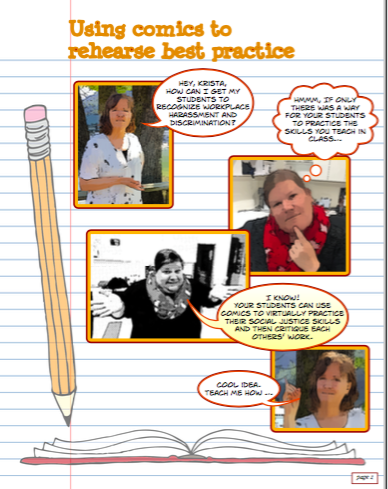
I story-boarded (using “Comic Life3”) a typical conversation with my tech-wizard colleague, Krista Lambert.
Inquiry: How do I work around students’ implicit bias and create a learning opportunity for evidence-based discussion of sexism and homophobia?
Strategy: I wanted to use students own lived experiences of sexism and/or homophobia. In addition, I wanted the learning process to unfold through social-construction. (Note: I co-presented — with Krista Lambert, M.Ed., the following lesson plan at eTUG,Spring 2017 and will present it again at Sketching-in-Practice, June 2017.)
Recipe for success. You will need:
- Comic book app “COMICBOOK!” – super easy
- Lecture. You could use a lecture on any best practice in your discipline. I used my lecture on about how to move from by-standing to upstanding. (Note: your students will be far more engaged if their scenario begins with an “Oops!” or “Oh no!” event that teams will then have to act out and remedy. Creating a comic about fixing a mistake is more entertaining than merely showing a model of perfect practice).
- Teams to create one comic each
- Blog (with comments function enabled) for a published “comic book”
- Ticking clock – to help students’ let go of perfectionistic standards and just “have a bash” at making the comic.
PDF: Here is our workshop handout: Jessica Motherwell Comic Rehearse Best Practices 2017-06jun-04
Learning outcome: This is a very fun lesson! Students avoided discussions of the stereotypical stories about sexism and homophobia and instead stayed focused on the EVIDENCE-based stories dramatized in the comics. The examples of upstanding depicted by each team were widely discussed. Each student commented on all other (i.e., not their own) teams comics. The comments were an important part of the learning as it was not uncommon for a student to say, “That happened to me, too!” I have offered this lesson plan for six terms and at conference workshops and it was a huge success each time.